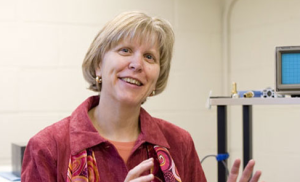Posted 8:58 a.m. Wednesday, April 23, 2014

For nearly two years, a robot has traveled the crater floor of Mars, zapping rocks and collecting samples. It will help scientists determine if the red planet could have ever supported life.
 M. Darby Dyar, a professor of astronomy at Mount Holyoke College and a scientist at NASA, will give a public lecture May 1.[/caption]
For nearly two years, a robot has been wheeling across a crater floor of Mars, zapping rocks and collecting samples in the name of science.
The Curiosity Mars rover will help scientists determine if the red planet could have ever supported life.
M. Darby Dyar, a professor of astronomy at Mount Holyoke College and a scientist at NASA, will share what the rover has uncovered thus far during a public lecture at UW-La Crosse. “A Year in the Life of Curiosity on Mars: New Discoveries from the Red Planet” will be at 5 p.m. Thursday, May 1, in Skogen Auditorium A, 1400 Centennial Hall. A reception starts at 4:30 p.m.
Dyar, is a member of the science team for NASA’s Curiosity Mars rover. She plans to address questions such as “How is the rover moving us toward manned missions and eventual human settlements on Mars? She will give an insider’s view into the daily life of the rover, its science and its accomplishments.
Dyar notes the mission cost every American taxpayer about $7 — the cost of a movie.
M. Darby Dyar, a professor of astronomy at Mount Holyoke College and a scientist at NASA, will give a public lecture May 1.[/caption]
For nearly two years, a robot has been wheeling across a crater floor of Mars, zapping rocks and collecting samples in the name of science.
The Curiosity Mars rover will help scientists determine if the red planet could have ever supported life.
M. Darby Dyar, a professor of astronomy at Mount Holyoke College and a scientist at NASA, will share what the rover has uncovered thus far during a public lecture at UW-La Crosse. “A Year in the Life of Curiosity on Mars: New Discoveries from the Red Planet” will be at 5 p.m. Thursday, May 1, in Skogen Auditorium A, 1400 Centennial Hall. A reception starts at 4:30 p.m.
Dyar, is a member of the science team for NASA’s Curiosity Mars rover. She plans to address questions such as “How is the rover moving us toward manned missions and eventual human settlements on Mars? She will give an insider’s view into the daily life of the rover, its science and its accomplishments.
Dyar notes the mission cost every American taxpayer about $7 — the cost of a movie.
“Yet, at that bargain price, we are moving toward answers to some of the most fundamental questions of human existence: Where did life come from? Are we alone?,” says Dyar. “This mission is not just about answering questions, but about getting the public interested in and motivated to participate in science.”Dyar is the third speaker to be featured in UW-L’s spring public lecture series in physics. The series started in April 2012 as a compliment to the university’s fall Distinguished Lecture Series, which features a Nobel Prize winner in Physics. This newer lecture series highlights the diversity of scholars in the physics and astronomy fields such as women and minorities, notes Shelly Lesher, UW-L assistant professor of physics. “Although the scientists in this lecture series have not won the Nobel Prize, they are certainty well recognized in their respective fields,” she says. Dyar also brings diversity in her field of study. She not only uses physics and astronomy in her career, but also chemistry and geology. Plus, her work for NASA has wide public interest, notes Lesher. Taviare Hawkins, UW-L assistant professor of physics, and Lesher received a grant from The Wisconsin Space Grant Consortium and sponsorship from the College of Science and Health to bring Dyar to campus. "In addition to Dr. Dyar being an excellent researcher, she is — first and foremost — an accomplished professor at a small liberal arts college. The Five Colleges students love her courses, so I think her talks will be interesting," says Hawkins. Not only that, the Mars rover has been making headlines and this will give the UW-L community an opportunity to hear a rover scientist speak and ask questions, notes Lesher. “I hope people take away a sense of pride that harkens back to the Apollo era, and are inspired by what science can accomplish on behalf of our country and the world,” says Dyar. During her stay, Dyar will visit classes and interact with UW-L faculty and students. She will also give a physics seminar “Calibrating ChemCam: Analytical Chemistry at Arm’s Length” at 3:20 p.m. Wednesday, April 30, in room 100, Cowley Hall. During the seminar, Dyar will talk about the transition to a new technique used on missions to distant planets and asteroids that is making one Star Trek fantasy not too far from truth. Star Trek’s mythical tricorder was a handheld probe that measured the chemistry of any object by shining a laser on it from up to 100 meters. The Laser-Induced-Breakdown Spectroscopy technique is now used on the ChemCam laser, a complex instrument on NASA’s Curiosity Mars Rover. The ChemCam allows scientists to do fieldwork in inaccessible locations and hazardous locales. The ChemCam allows Dyar to search Martian minerals for Hydrogen and water.
